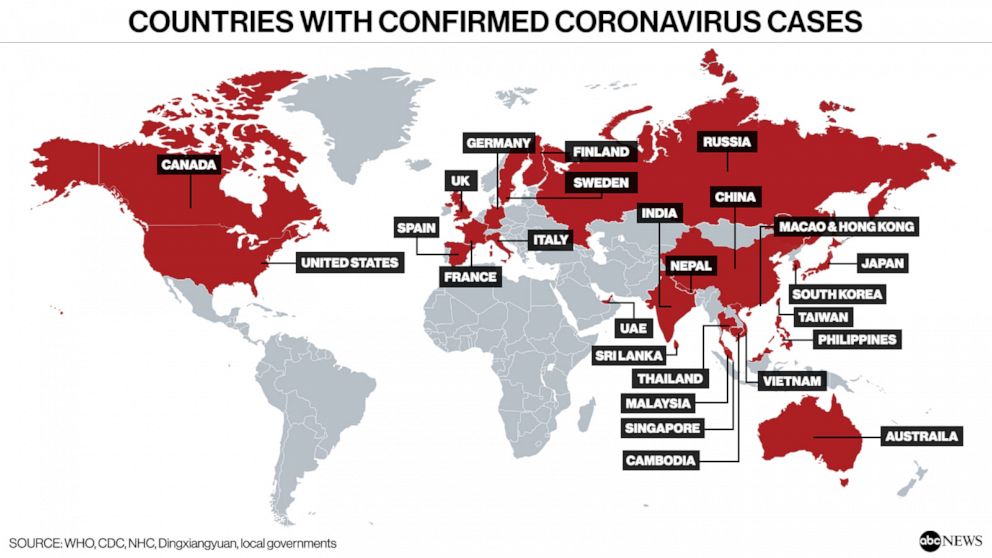Here are the coronavirus symptoms to watch out for amid outbreak
The U.S. has now confirmed 11 cases of the coronavirus in U.S. patients. Six patients are located in California, two in Illinois and one individual each in Massachusetts, Washington state and Arizona.
Nine of the patients had traveled to China, and two contracted it through human-to-human transmission, in both cases between a husband and wife.
Authorities in Wuhan, the city at the epicenter of the coronavirus outbreak, imposed quarantine-like restrictions on the city of 11 million Jan. 21, as they raced to stop the spread of a new coronavirus that's popping up in countries around the world. Those restrictions were later extended to additional cities, cutting off travel to millions of people during the busy Chinese New Year travel period.

In Wuhan, where hospitals are struggling to keep up with the influx of patients seeking treatment, the city fast-tracked a new 1,000-bed hospital, which started receiving patients this week. The hospital was finished less than 10 days after the city began construction on the facility. A second fast-tracked hospital is slated to be completed Feb. 5, and should start taking patients the following day.
As the situation rapidly unfolds, here's what you need to know:
What are the new coronavirus' symptoms?
Symptoms of the new coronavirus are similar to pneumonia, and can range from mild symptoms, like a slight cough, to more severe symptoms, including fever and difficulty breathing, according to the Centers for Disease Control and Prevention.
Some patients who have been diagnosed with the coronavirus had lesions on their lungs, which were uncovered through X-rays.
How is the virus transmitted?
Chinese health authorities confirmed Jan. 20 that the virus has been transmitted between humans. While many of the original reports of the virus in Wuhan were among people who worked at or visited a seafood and live-animal market, cases among people who weren't connected to the market have mounted in recent weeks.
That market was closed and fumigated on Jan. 1.
Since then, several countries outside of China, including the United States, have reported instances of human-to-human transmission of the virus. For now, the World Health Organization believes that the disease's incubation period is between two and 14 days, a wide range.
A report in the Lancet, published Jan. 24, suggested that people who contract coronavirus might be able spread the disease before they develop symptoms.
Doctors in Germany published a letter in the New England Journal of Medicine Jan. 30 reporting the case of German patient who contracted coronavirus from his business partner. She was visiting from China and didn't have symptoms during the course of her stay.
It's not yet known how common asymptomatic transmission of the disease might be.

Adding to concerns are cases of the disease in health care workers in Wuhan, which health experts previously said was a key population at risk for being sickened, as they were during previous outbreaks of SARS and MERS.
The new coronavirus is in the same family as SARS, MERS and the common cold. Coronaviruses often circulate among animals and can jump from animal to human.
In rare cases, those viruses can mutate and spread from person to person.
How many people have been affected?
As it stands, 20,478 cases of the new coronavirus have been reported in China. Additional cases have been reported in at least 23 countries, including in the United States.
At least 425 deaths have been reported in China, and two death outside of mainland China, one in the Philippines and one in Hong Kong.
What should I know about the coronavirus cases in the US?
The first case of coronavirus reported in the U.S. was in a patient in his 30s from Washington state, the CDC announced Jan. 21. Laboratory testing at the CDC in Atlanta confirmed the patient was infected with the disease. Although the patient had traveled to Wuhan, he said he did not visit the market at the center of the outbreak.
After being hospitalized, the patient was discharged in February and is in isolation at home, according to health officials in Washington.
"We understand that some people are worried about this virus and how it may impact Americans," said Dr. Nancy Messonnier, director of the CDC's National Center for Immunization and Respiratory Diseases.
"The immediate risk to the U.S. public is low at this time," Messonnier said.
Additional cases have since been reported in Illinois, California, Arizona and Massachusetts.
How is the world responding?
Countries around the world have stepped up airport screenings, and in some cases, closed their borders in response to the rapidly evolving outbreak.

The World Health Organization declared coronavirus a public health emergency of international concern last week and airlines around the world suspended flights to China. In the United States, Delta Airlines, United Airlines and American Airlines suspended all U.S. flights to China in rapid succession last week.
This week, American Airlines announced that it would suspend flights to Hong Kong, due to "declining demand."
On Jan. 31, U.S. Secretary of Health and Human Services Alex Azar declared a public health emergency in the United States and announced a temporary travel ban.
ABC News' Christine Theodorou, Mina Kaji and Tanya Stukalova contributed to this report.




